Minnesota Spina Bifida Association
No One Affected By Spina Bifida Should Face This Alone.
Minnesota families living with spina bifida find guidance, community, and hope with MNSBA.
MNSBA
Why We Need Each Other
In Minnesota, about 2,900 people live with spina bifida—yet only 475 are connected through the Minnesota Spina Bifida Association. That means thousands of families are left isolated, overwhelmed, and without dependable support.
Spina bifida is a serious, lifelong condition that affects mobility, bladder and bowel function, orthopedic health, and often requires ongoing medical care and surgeries. Families need more than doctors—they need answers, community, and real help.
The Minnesota Spina Bifida Association (MNSBA) is a Support Group. Part of Its Mission is to sponsor events to connect families.
How We Help

Meaningful Connection Through Events
Family walks, picnics, bowling outings, and Twins games

Financial Aid & Opportunities
Scholarships, camperships, “Be Active” grants, and gift cards

Regular Touchpoints
Peer events, statewide meetings, youth conferences, support groups, and newsletters

Trusted Resources
Referenceable guides, websites, medical news, and peer-reviewed information

Join our compassionate community
Membership is free and inclusive.

Engage in events and resources
Designed for families like yours.

Support through donations
Every dollar funds aid, events, and connection.
Join our Community
Your Next Steps
Take the first step toward connection and support. Whether you’re looking to join a caring community, participate in meaningful events, or give back through donations, your involvement helps strengthen families and create lasting impact. Together, we can build a network of compassion, resources, and hope.
Spina Bifida
Common FAQ
What is Spina Bifida?
Spina Bifida is a neural tube defect that occurs when the spine and spinal cord don’t form properly during early pregnancy. It can cause physical and neurological challenges that vary in severity.
How common is Spina Bifida?
Spina bifida occurs in about 7 of every 10,000 births in the U.S.
How many people in Minnesota have Spina Bifida?
Around 2,900 Minnesotans live with the condition.
What are the types of Spina Bifida?
The three main types are:
-
Spina Bifida Occulta (mild, often no visible symptoms)
-
Meningocele (a fluid-filled sac outside the spine without nerves)
-
Myelomeningocele (most severe, spinal cord and nerves protrude through an opening in the spine)
How is Spina Bifida diagnosed?
It can often be detected during pregnancy through blood tests, ultrasound, or amniocentesis. Sometimes, it’s diagnosed at birth.


Since 2022, our Be-Active Grants and Camperships have opened doors for 81 kids to join over 100 programs—with more than $26,000 donated to support their experiences.
Join our mission. Volunteer, Donate, Advocate.
Get Started Today.
With every new member, event attendee, and donor, no Minnesota family faces spina bifida alone—and every individual has the chance to fully participate in life.
